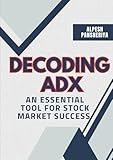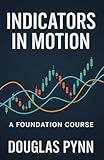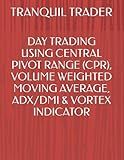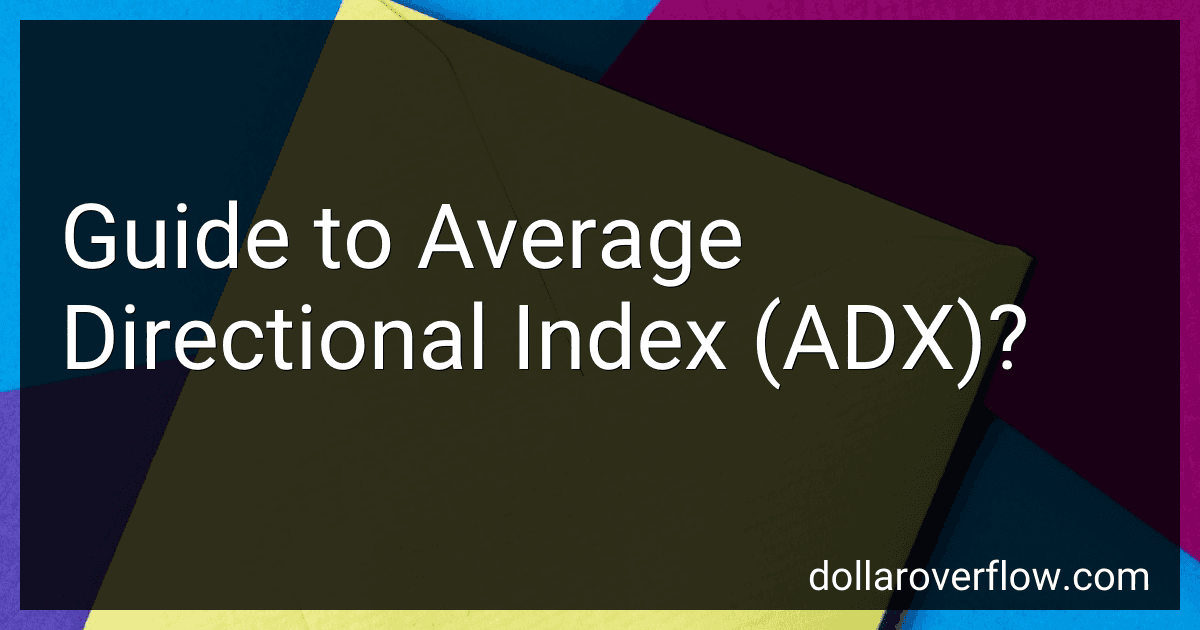Best ADX Trading Tools to Buy in December 2025

Decoding ADX: An Essential Tool for Stock Market Success (Pro Trader Advanced Strategy and Next Level Special Indicators Series-3)



SURE SHOT MONEY TRADING STRATEGY USING TRIPLE EXPONENTIAL MOVING AVERAGE (TEMA), QQE (QUALITATIVE QUANTITATIVE ESTIMATION) INDICATOR AND ADX/DMI



Buy High Sell Higher: Day Trading using High-Low Moving Average, MACD, ADX/DMI & Chaikin Volatility Indicator



Indicators in Motion: A Foundation Course (The Market Architect: An Institutional Edge Series)



DAY TRADING USING CENTRAL PIVOT RANGE (CPR), VOLUME WEIGHTED MOVING AVERAGE, ADX/DMI & VORTEX INDICATOR



Forex & Crypto Day Trading Strategy combining Qstick Indicator, ADX, Money Flow Index & ATR Trailing Stops



Como Day Trade Long-Short usando o indicador de volatilidade Chaikin, oscilador de previsão Chande, ADX e análise de volume (Portuguese Edition)


The Average Directional Index (ADX) is a technical analysis indicator that helps traders determine the strength and direction of a trend in a financial market. It was developed by J. Welles Wilder and introduced in his book "New Concepts in Technical Trading Systems".
The ADX consists of three lines: the ADX line, the Positive Directional Indicator (+DI), and the Negative Directional Indicator (-DI). These lines are plotted on a chart and can vary between values of 0 and 100.
The ADX line itself represents the strength of the current trend. A higher ADX value indicates a stronger trend, while a lower value suggests a weaker trend. Traders often consider a value above 25 as a signal of a strong trend, regardless of whether it is an uptrend or a downtrend.
The +DI line measures the strength of the upward movement in the market, while the -DI line measures the strength of the downward movement. The direction of each line can also provide insights into the market trend. If +DI is above -DI, it suggests a bullish trend, and if -DI is above +DI, it suggests a bearish trend.
Traders can use the ADX indicator in various ways. One approach is to use the ADX line itself to determine the strength of the trend. If the ADX line is rising, it indicates a strengthening trend, and if it is falling, it suggests a weakening trend. Another approach involves analyzing the crossovers between the +DI and -DI lines. A bullish signal is generated when +DI crosses above -DI, and a bearish signal occurs when -DI crosses above +DI.
Additionally, the ADX can be used to identify potential trend reversals. For example, if the ADX line has been rising steadily but suddenly starts to decline, it could indicate that the current trend is losing strength and a reversal might occur.
It's important to note that the ADX is not a directional indicator itself, meaning it does not indicate whether the trend is up or down. Instead, it helps traders assess the strength of a trend, allowing them to make informed trading decisions.
Like any technical analysis tool, the ADX has limitations. It may lag during choppy or range-bound markets, as it is primarily designed to identify trends. Therefore, it is often used in conjunction with other indicators or price action analysis to improve its effectiveness. Traders should also consider using appropriate risk management strategies to minimize potential losses when using the ADX or any other indicator.
What is the difference between a smooth ADX and a regular ADX?
The difference between a smooth Average Directional Index (ADX) and a regular ADX lies in the calculation and interpretation of the two indicators:
- Regular ADX: The regular ADX is a technical indicator used to measure the strength of a trend. It is represented by a single line ranging from 0 to 100. A higher ADX value indicates a stronger trend, while a lower value suggests a weaker trend or a sideways market. The regular ADX considers the true range values and Directional Movement Index (DMI) components, namely positive directional movement (+DI) and negative directional movement (-DI), to calculate the final ADX reading.
- Smooth ADX: The smooth ADX is an improved version of the regular ADX, which incorporates smoothing techniques into its calculation. The purpose of smoothing is to reduce market noise and provide a clearer depiction of the trend strength. Several methods can be employed to smooth the ADX calculation, such as exponential moving averages (EMAs) or simple moving averages (SMAs). The addition of smoothing helps to generate a smoother ADX line, filtering out short-term fluctuations, and potentially providing more reliable trend strength readings.
In summary, the regular ADX is a simple measure of trend strength, while the smooth ADX adds additional calculations to smoothen the indicator and potentially provide clearer trend strength signals.
How to set up alerts based on the ADX indicator?
To set up alerts based on the ADX (Average Directional Index) indicator, you typically need a charting platform or trading software that supports alert functionality. Here is a general step-by-step guide on how to set up alerts based on the ADX indicator using various platforms:
- Find a charting platform or trading software that supports alert features. Examples include MetaTrader 4 (MT4), TradingView, Thinkorswim, or any other platform of your choice.
- Open the platform and select the chart you want to set up alerts on.
- Locate the ADX indicator in the platform's indicator library. Usually, it can be found under "Oscillators" or "Trend Indicators."
- Apply the ADX indicator to your chart by simply dragging and dropping it onto the chart or selecting it from the indicator options.
- Configure the parameters of the ADX indicator according to your preferences. Common settings include the period (typically 14) and the sensitivity level.
- Once the ADX indicator is applied and customized, look for the alert feature in your platform. It can usually be found in the toolbar or the indicator settings.
- Click on the alert feature, and a dialog box will appear. Enter the conditions for your ADX alert. This may include crossing a specific threshold level, reaching an overbought or oversold zone, or any other criteria you deem relevant.
- Set up the notification preferences for your alert, such as email, phone, or desktop notification. Ensure you have the necessary settings and permissions in place to receive the alerts.
- Save and activate your ADX alert. Confirm that the alert is enabled and functioning as expected.
- The platform will continuously monitor the ADX indicator based on your defined conditions and send you an alert whenever the conditions are met.
Remember to regularly review and update your alert settings as market conditions and trading strategies evolve. Additionally, practice proper risk management and analysis alongside the alerts to make informed decisions.
How to use the ADX to identify trend reversals?
The Average Directional Index (ADX) is a technical indicator that can be used to measure the strength of a trend. While it is primarily used to determine the strength of a current trend, it can also help identify potential trend reversals. Here's how you can use the ADX for this purpose:
- Confirm a strong trend: Before looking for potential reversals, it's important to establish that there is a strong trend in place. The ADX can help determine the strength of the current trend. Generally, a reading above 25 is considered to indicate a strong trend.
- Look for divergences: When the price of an asset is making higher highs, but the ADX is making lower highs, it indicates a bearish divergence and suggests that the trend may be losing strength. Conversely, when the price is making lower lows, but the ADX is making higher lows, it indicates a bullish divergence and suggests that the trend may be weakening.
- Monitor ADX readings near key levels: Pay attention to the ADX readings when the price approaches key support or resistance levels. A significant drop in the ADX reading near a resistance level could indicate a potential trend reversal to the downside. Conversely, a significant increase in the ADX reading near a support level could indicate a potential trend reversal to the upside.
- Observe ADX crossovers: In some cases, the ADX line (typically a solid line) crosses above or below another line called the directional movement index (DMI) line (typically a dotted line). When the ADX line crosses above the DMI line, it suggests a strengthening trend. However, when the ADX line crosses below the DMI line, it suggests a weakening trend and potential reversal.
- Combine with other indicators: The ADX should be used in combination with other technical indicators or chart patterns to increase the accuracy of identifying trend reversals. This could include using trendlines, moving averages, or other oscillators.
Remember, the ADX is not a guaranteed predictor of trend reversals, but rather a tool that can be used in conjunction with other analysis techniques to increase the likelihood of identifying potential reversals. It is important to conduct thorough analysis and consider multiple factors before making any trading decisions.
What is the Average Directional Index (ADX) used for?
The Average Directional Index (ADX) is a technical analysis indicator used to measure the strength, trend, and momentum of a market. It helps traders identify whether a market is trending or not, and the strength of that trend.
The ADX is typically used in conjunction with other indicators to generate buy or sell signals. It consists of three lines:
- The ADX line itself, which indicates the overall strength of the trend.
- The Positive Directional Indicator (+DI), which measures the strength of the upward trend.
- The Negative Directional Indicator (-DI), which measures the strength of the downward trend.
Traders use the ADX to determine the presence and strength of a trend. A reading above 25 is often considered indicative of a trending market, while a reading below 20 indicates a sideways or range-bound market. Additionally, the ADX can help traders determine when a trend is losing strength or gaining momentum, assisting in trade entry and exit decisions.
